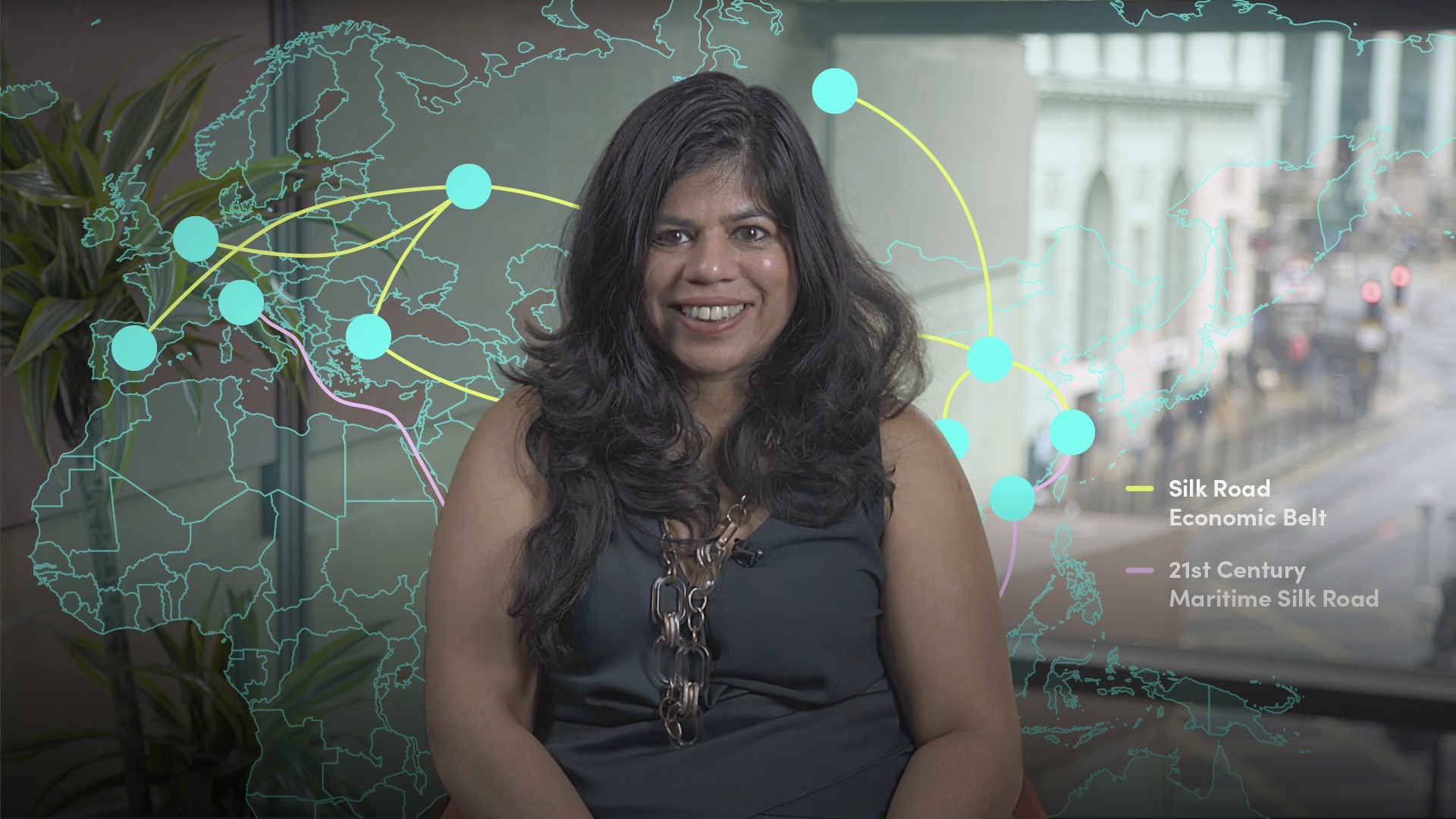
Introduction to China's Belt and Road Initiative

Sharmila Whelan
20 years: Asian economics & policy
Sharmila analyses China's Belt and Road Initiative and examines the financing that made it possible. She evaluates the risks, opportunities and implications of the investment.
Sharmila analyses China's Belt and Road Initiative and examines the financing that made it possible. She evaluates the risks, opportunities and implications of the investment.

Introduction to China's Belt and Road Initiative
19 mins 37 secs
Key learning objectives:
Learn how the Belt and Road Initiative will connect the world
Outline the benefits and drawbacks of the project
Comprehend the economic risks that come with financing the initiative
Overview:
China’s Belt & Road Initiative is hailed as the greatest infrastructure project of all time connecting countless countries by land and sea. It will require almost USD$1 trillion in funding. Despite the benefits however, there are many risks and criticisms that have hindered the success of the project.
What is China’s Belt & Road Initiative?
The Belt & Road Initiative (BRI) is a transcontinental development strategy announced in 2013 by China’s President Xi Jinping. Hailed as the greatest infrastructure project ever undertaken, BRI aims to create a unified Eurasian market, with China at the epicentre by reviving and extending the original Silk Road and investing in sea routes. The two main segments of the initiative are the land-based "Silk Road Economic Belt" and the seagoing "21st Century Maritime Silk Road”. While the focus is on transport, energy and information infrastructure connecting Asia, Europe and Africa, the programme has bigger and grander aspirations. The project is an enormous endeavour. The Silk Road Economic Belt comprises six land corridors connecting China with South East Asia, South Asia, West Asia and the Middle East, and from there, Europe. Projects identified thus far include a network of highways, railways, air and sea routes, ports, gas and oil pipelines, power grids and internet connections and a number of cultural exchanges.
The 21st Century Maritime Silk Road meanwhile, focuses on using Chinese coastal ports to link the country with Europe through the South China Sea and Indian Ocean, and connect China with the South Pacific Ocean through the South China Sea.
How much will it cost, and who will fund this?
In 2013 when President Xi announced China’s BRI project, a price tag of US$900bn was put on it. China’s commitment is large and rising even as it steps up efforts to bring on board multilateral agencies, the likes of the IMF, World Bank and ADB, other governments and private sector investors. China is using a mixture of government financing for the projects including encouraging policy banks and other financing institutions to get involved. To tap international capital China has helped create a number of multilateral funding entities. The key ones are the Asian Infrastructure Investment Bank (AIIB), the New Development Bank (NDB), the Silk Road Fund (SRF) and other contributions from China’s central bank and the Agricultural Development Bank of China (ADBC).
What are the Motivations, Criticisms & Implications?
So are China’s motivations purely selfless? There is a healthy degree of suspicion about China’s motivations. Critics see BRI as focused on accruing a range of benefits for China, including: creating opportunities to generate higher returns on China’s vast foreign exchange reserves, helping China’s state owned enterprises in construction and engineering to deploy abroad in search of more work and higher returns, ensuring China’s excess industrial capacity is exported to regional markets, expanding China’s export markets and boosting the internationalisation of the renminbi.
At the same time, others worry big-ticket projects in unstable and corrupt countries could see China’s debt climb higher. There are concerns that BRI is a form of economic imperialism that gives China undue leverage over other countries, often those that are smaller and poorer. Others worry an expanded Chinese commercial presence around the world will eventually lead to an expanded military presence.
BRI will open up new markets for Chinese goods. China hopes to reduce trade barriers while promoting regional economic integration and has signed 14 free trade agreements involving 20 countries. If successful, BRI will shift global trading and investment patterns in China’s favour.
China is not the sole winner. For some BRI partner countries, the lack of infrastructure is a binding constraint on growth, and yet most BRI countries have struggled to increase investment, hindered by low domestic savings rates and credit worthiness which has in turn affected their ability to tap international capital markets. China’s BRI has the potential to re-shape the countries it touches by increasing bilateral and multilateral trade, crowding in investment, creating jobs and allowing countries to exploit their comparative advantages through specialisation.
What are the Risks & Opportunities?
BRI is not without its risks. BRI debt distress has been making the news headlines. If strategically important countries on the BRI land and sea routes run into debt problems this could delay the rollout and/or lead to material losses for Chinese banks and Chinese state owned enterprises. Today China is more sensitive to exogenous shocks. Chinese overseas assets have risen rapidly since the global financial crisis. Foreign currency loans extended by Chinese financial institutions are increasing as BRI gains momentum. While China’s formidable international reserves mean that it can absorb sizeable BRI debt default losses, the potential risks to the domestic economy are not inconsequential. If BRI related foreign currency non-performing loans were to spike it could become the back door through which a domestic financial crisis is precipitated. It is not a clear and present danger but a medium term possibility. China’s policymakers are acting to manage, diversify and reduce risk.

Sharmila Whelan
There are no available Videos from "Sharmila Whelan"

